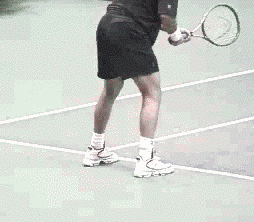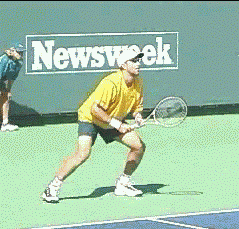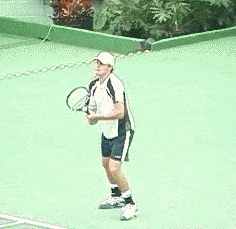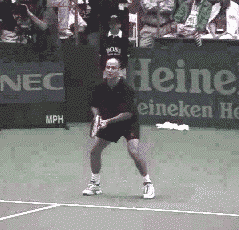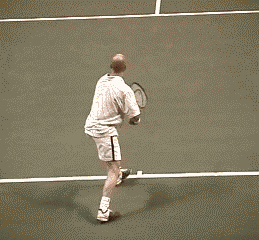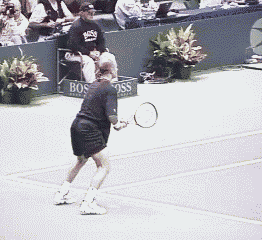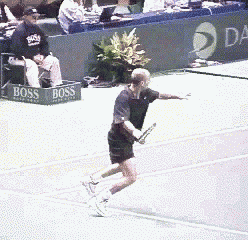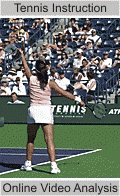|
TennisOne Lessons
Andre Agassi - Lord of the Returns Learn From the Best Ever by Heath Waters Go to any Pro and you will hear, the two most important shots in tennis are the serve and the return. The reason they are considered by many to be so significant is because they happen to begin each and every point and just as importantly, determine whether a player will start the point from a defensive, neutral, or offensive position. In today's article we will specifically study the return technique of arguably the greatest service returner of all time, Andre Agassi. We will break down his return and show you the essential elements that you can learn from and apply to your own game.
So much of how one plays the game of tennis is determined by how one perceives they are supposed to play the game of tennis. This perception is predominantly based upon the influences of coaches, parents and the general tennis population. These influences impact how we approach the game. Once in awhile, however, there comes along a player that knocks down these walls of normalcy and dares to walk where no player has walked before. Through self-discovery and trial and error they find ways to propel the game of tennis past what once was thought possible. Agassi happens to be one of these players. He can be credited with making the swinging volley, standing on or inside the baseline during point play, and attacking the opponent's serve commonplace in today's game. Agassi has chosen to approach the return as not merely a shot to put back into play and start the point, but as an opportunity to attack and put himself on the offensive position right off the bat. While other players are merely happy to get a 130mph serve back over the net, Agassi sees this as an opportunity to attack and get inside his opponent's head. After all the game of tennis is about mentally breaking down your opponent and Agassi not only believes this but lives it on a daily basis. I truly believe that what one believes they can do they WILL do. Sometimes, the limitations we set upon ourselves keeps us from discovering our true potential and taking our game to new heights. For you to get a full understanding of the technical elements of Agassi's return, I felt it important to explain Agassi's mental approach, as sometimes it is valuable to know the why of a technique before you know the how.
So now lets get to the “how” of Andre Agassi's forehand return technique. We will put the return into three steps:
The Footwork The first thing to observe is the athletic stance. Agassi starts his ready position with his feet parallel to each other and his knees are flexed in a balanced position. From here Agassi will initiate his forward movement by stepping forward and performing a split step. The important thing to notice is that he is timing this forward split split-step to coincide with the server's motion. While the server is doing his wind up Agassi will begin to move forward and jump into his split step. His goal here is to land on the ground at the same time his opponent's ball lands on the strings. The split step timing is crucial in that it determines how well a jump you get on the ball. Notice that when Agassi lands he simultaneously pivots and pushes off the left foot towards the forehand side. After he uses the left foot to push towards the right or forehand side then the right leg takes over, using it to drive his weight forward towards the intended target. Look at the example above over and over to observe these elements of Andre's footwork and then stand up and practice them yourself. The footwork technique is essential in that it determines his reaction time to his opponents 130mph serve and guarantees proper weight transfer into his shot. The Preparation What sets Agassi's preparation apart from other great players? In the clips on the right, notice that Agassi keeps his left hand on the racquet longer than either Rafter or Roddick and obtains a greater coil of the upper torso than his two counterparts also. Observe the left shoulder positions of the three players at the end of the clips and you will see Agassi's shoulder is much more coiled. This is the second essential element to mimic for a great return and your cue is to simply keep the left hand on the racquet longer during your takeback. This allows for more kinetic energy to be unleashed into contact. Agassi is a master at getting power that others do not from the use of efficient body coil. The next thing to observe is the position of Agassi's hand during the final preparation position. Notice the difference between his normal forehand ground stroke preparation and compare it to his forehand return preparation.
What we see here are two different hand positions in the final preparation phase. On a regular groundstroke, Agassi's right hand and racquet are well above his shoulder. He uses this higher preparation to generate more racquet speed because the incoming ball is traveling at a slower rate than the 130mph serve. On the return, Agassi's hand positioning is much lower. He needs only a minimal back swing on a 130mph serve return to generate the same power as he would obtain from a 60-70mph incoming groundstroke with a full back swing. The last thing to note is not necessarily where the racquet goes on the back swing but rather where the hand is placed. Agassi places the hand directly behind the flight path of the incoming ball and on the same level at which he plans to make contact.
On the regular groundstroke Agassi places the hand directly behind the flight path of the ball, yet the hand is much higher than contact so as to be able to generate that so important racquet speed he desires. The Contact and Ending The first thing to note is the upper body position - it is still in a coiled position as Agassi pushes his weight off his right leg and transfers his weight towards his intended target. Because of this forward momentum and weight transfer, Agassi almost always ends with his feet inside the baseline. This not only helps guarantee weight transfer but also, equally important, enables him to make contact in his power zone (at waist height) utilizing the power of his opponents serve to his advantage. There is a method to his madness and I encourage all tennis players to learn from and mimic the fundamental elements that make Agassi's return so intimidating. So I challenge each of you today to approach the game of tennis from a new perspective. Not one with fear and trepidation, but rather with courage, that challenges you to attempt things you once considered impractical. No matter what level you are, you can take your tennis game to new heights if you are willing to step outside the norm, knock down your own self imposed walls and limitations, and begin to approach the game of tennis from a fresh perspective. There you have it. I have broken down the forehand return of Andre Agassi into three easy to learn steps for you to practice and master, the footwork, the preparation, and the hitting zone. So stand up, get your racquet, hit the courts, and master each step one at a time, then put them all together and you are well on your way to having an intimidating return just like Andre.
This invaluable visual comparison, combined with the detailed analysis by a current tour professional coach, offers the most advanced and unique learning environment in tennis. Pro Tech will store your video lessons for two years on your own web page, so you and your coach can evaluate your progress from anywhere in the world. TennisOne members receive a 10% discount. |

